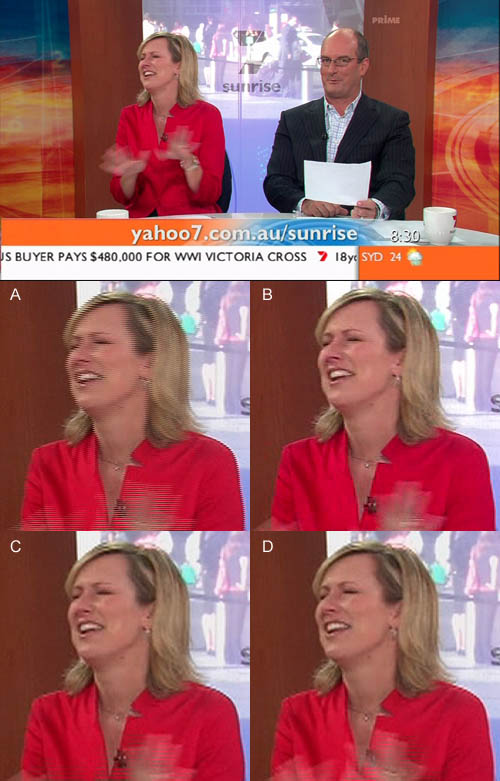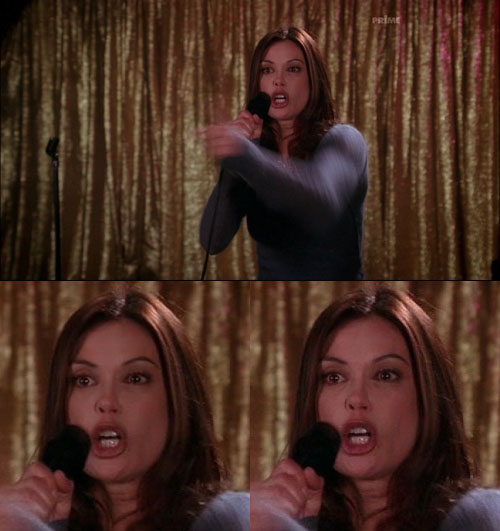
Substantially revised version of an article originally published in The Canberra Times, 26 March 2007, p.23 of 'The Guide'
The Federal Government has decreed that HDTV shall be a resolution of 1080i, 720p or 576p. The 'i' stands for interlaced, while the 'p' stands for progressive. But there's one problem with this: nowhere else in the world is 576p regarded as high definition. After all, standard definition is 576i, so the resolution is identical.
Potentially, 576p could be a little better, providing smoother motion than 576i, on studio camera work if 576p cameras are used. But for movies and the majority of recent TV shows, if you use a good TV there will be no difference in quality at all between 576p and 576i.
Let me illustrate. On this page you will see two pictures which demonstrate these points. The lady in red is from Prime's 'Sunrise' program. Since this is a live show, video cameras are used rather than film cameras.

The top section of the picture is the full frame captured from the HD broadcast. It's there only to give you a scale. Below this are four different versions of one detail of the full frame.
A is the SDTV version, and it is very clearly interlaced. B is the HDTV version, which is not interlaced. So instead of those nasty jagged lines, or a softening of the picture due to a TV's processing, all the detail is retained.
On all actual TV displays, those jagged lines (called combing) in A will not be visible because electronic processing eliminates it. In the process, though, it loses detail and sharpness. C is the same as A, except that I have processed it to remove the interlacing, by eliminating all the even-numbered lines, and replacing them with lines interpolated from the nearest odd-numbered lines. D is also the same, except that in this case I eliminated the odd-numbered lines. Note these look slightly different to each other because the video camera captured them one fiftieth of second apart in time. Notice, also, the jaggies that appear on the hard edges of both of these processed areas, despite Photoshop doing the best it could with the interpolation.

But check out the dark haired lady. This was from 'Desperate Housewives', which is shot on 35mm film and subsequently transferred to video. You may see a subtle colour variation between the two, but that is the only difference. Yet the one on the left came from SDTV and that on the right came from HDTV.
In practice, with 'Desperate Housewives', most other evening drama, and virtually all movies, the HDTV transmission sends exactly the same frames over the airwaves as SDTV, but sends each one of them twice.
Higher resolution? No way.
Prime complicates matters further. Presently SBS and ABC broadcast all their programming on their HDTV channels (merely upconverting most of it to 576p and 720p respectively). WIN and Southern Cross only broadcast high definition programs on their HDTV channels, and the rest of the time broadcast a high definition demonstration tape. The advantage of this is that you know for certain whether the program really is high definition or not.
But Prime does something strange. It only broadcasts high definition programs on its HD channel. But instead of upconverting regular programs between the high definition programs, or broadcasting a demonstration tape, it switches off the HD channel when there are no HD programs showing. That's oversimplifying a little. The HD channel actually transmits a switching signal which tells your HDTV to switch over to the regular SD Prime broadcast.
That leads to problems. In particular, at least two different HD set top boxes I've reviewed have failed to act on the switching signal. If you scan for stations when Prime is actually broadcasting HD, then they will only show the HD programs on Prime HD, and a black screen in between times. But if you happen to scan for stations when Prime has the HD channel switched over to SD, then these units remain locked on SD and you will never receive Prime's HD programming.
Happily, Channel 7 in Melbourne and Sydney is currently testing 1080i broadcasting, so maybe we will one day get real high definition on Prime here in Canberra.